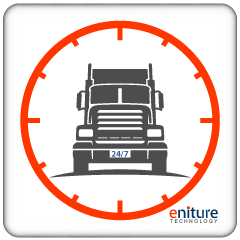The Real Time Shipping Quotes app for Shopify retrieves your negotiated shipping rates, takes action on them according to the app settings, and displays the results as shipping options during checkout. The app can be configured to quote parcel and LTL freight shipments. See the Providers tab below for a list of supported shipping companies.
SETUP TUTORIAL & DEMO (8:36 min)
Basic Plan $30/month
Enable one shipping provider.
Features Unique to LTL Freight Providers
Retrieves your negotiated LTL freight rates for the enabled LTL freight provider.
Supported origins: United States and/or Canada depending on the capabilities of the enabled LTL freight provider.
Supported destinations: United States and/or Canada depending on the capabilities of the enabled LTL freight provider.
Customize the text used to label LTL freight quotes displayed to shoppers.
Options for how to offer lift gate delivery including an option to require lift gate delivery when the address type is identified as residential.
Specify the weight of your handling unit (e.g. pallet) so that it is accounted for in the shipping quote.
Identify the maximum weight per handling unit to extrapolate the number of handling units to account for in the shipping quote.
Features Unique to Parcel Shipping Providers
Retrieves your negotiated parcel rates for the enabled parcel shipping provider.
Supported origins: United States and/or Canada depending on the capability of the enabled provider.
Supported destinations: Any country that Fedex, Purolator, or UPS provide service to. Some UPS resellers available in the app will not return a quote to destinations outside the United States.
Select which services to offer to your shoppers.
Mark up or mark down individual services by a dollar amount or percentage.
Retrieve hyper-accurate parcel quotes even when charges are based on dimensional weight when using the built in packaging algorithm. Use of the optional Standard Box Sizes feature required.
Elect to include insurance in the shipping quotes when specific products are in the shopping cart.
Features Common to LTL Freight and Parcel Shipping Providers
Elect to display the carrier’s transit time or estimated delivery date with the rate estimate.
Define multiple warehouse locations.
Identify products that drop ship from vendors.
Always quote shipments as going to commercial or residential addresses or have the app automatically detect the address type to dynamically include the residential delivery fee in the shipping quotes.
Choose not display shipping quotes if a post office box is detected.
Mark up quotes by a dollar amount or percentage.
Support for products that ship hazardous material.
Offer an option for in-store pick up based on the customer’s distance from your warehouse.
Offer local delivery based on the customer’s distance from your warehouse.
Charge a fee for local delivery.
Dynamic presentation of LTL freight and parcel rates when both types of providers are enabled.
Standard Plan $55/month
Enable up to three shipping providers.
Advanced Plan $75/month
Enable up to five shipping providers.
Enterprise Plan $90/month
Enable up to eight shipping providers.
LTL Freight Providers
ABF Freight (Origins: Canada, USA | Destinations: Canada, USA)
Averitt Express (Origins: USA | Destinations: Canada, USA)
CDN Logistics (Origins: USA | Destinations: USA)
Central Transport (Origins: USA | Destinations: USA)
CH Robinson / FreightQuote by CH Robinson (Origins: Canada, USA | Destinations: Canada, USA)
Day & Ross (Origins: Canada | Destinations: Canada, USA)
Daylight Transport (Origins: USA | Destinations: Canada, USA)
Echo Global Logistics (Origins: USA | Destinations: USA)
Estes Express (Origins: USA | Destinations: Canada, USA)
FedEx Freight (Origins: Canada, USA | Destinations: Canada, USA)
Gain Consulting (Origins: USA | Destinations: USA)
GlobalTranz/WWEX Group (Origins: USA | Destinations: Canada, USA)
KDL Logistics (Origins: Canada, USA | Destinations: Canada, USA)
Kuehne+Nagel (Origins: Canada, USA | Destinations: Canada, USA)
Old Dominion Freight Lines (ODFL) (Origins: USA | Destinations: Canada, USA)
PITT OHIO (Origins: USA | Destinations: USA)
Polaris Transport (Shipping Lanes: Canada to USA | USA to Canada)
Priority 1 (Origins: USA | Destinations: USA)
Quick Transfer (Origins: USA | Destinations: USA)
R+L Carriers (Origins: USA | Destinations: Canada, USA)
Redhawk Logistics (Origins: USA | Destinations: Canada, USA)
Roadrunner Freight (Origins: USA | Destinations: Canada, USA)
Saia (Origins: USA | Destinations: Canada, USA)
Southeastern Freight Lines (SEFL) (Origins: USA | Destinations: Canada, USA)
TForce (Origins: Canada, USA | Destinations: Canada, USA)
TQL (Total Quality Logistics) (Origins: USA | Destinations: Canada, USA)
Unishippers/WWEX Group (Origins: USA | Destinations: Canada, USA)
Worldwide Express/WWEX Group (Origins: USA | Destinations: Canada, USA)
XPO Logistics (Origins: USA | Destinations: Canada, USA)
Parcel Shipment Providers
FedEx (Origins: Any country serviced by FedEx | Destinations: Any country serviced by FedEx)
FedEx via CH Robinson (Origins: Any country serviced by FedEx | Destinations: Any country serviced by FedEx)
TriNet Global Logistics (Origins: USA | Destinations: Any country serviced by UPS)
Unishippers (Origins: Canada, USA | Destinations: Any country serviced by UPS)
UPS (Origins: Canada, USA | Destinations: Any country serviced by UPS)
UPS via ShipEngine (Origins: USA | Destinations: Any country serviced by UPS)
USPS (Origins: USA | Destinations: Any country serviced by USPS)
Worldwide Express (Origins: Canada, USA | Destinations: Any country serviced by UPS)
Current version: 1.0
Requirements
A Shopify account with the Real-Time Carrier Shipping feature enabled. The feature is standard on the Advanced Shopify subscription package. It can be added to other packages by contacting Shopify customer service. (Learn more)
An established account with the shipping company or companies you intend to enable in the app.
FAQs
How do I get support for this application?
The knowledge base is the best 24/7 resource for support. Click here to go to the knowledge base. You can open a support ticket by emailing support@eniture.com. Customer support can also be contacted by phone at 404-369-0680 x2 on business days between 9:00 AM and 5:00 PM Eastern Time. If you get voicemail, leave a message and we will return your call.
How do I get an account?
Instructions for how to obtain an account with a shipping provider is available in the app. Follow the steps to enable the shipping provider to see the instructions for that provider.
Why are the shipment charges I received on the invoices from my carriers different than what was quoted by the plugin?
Common reasons include a difference in the quoted versus billed shipment parameters (weight, dimensions, freight class), or additional services (such as residential delivery) were required. Compare the details of the invoice to the shipping settings on the products included in the shipment. Consider making changes as needed. Remember that the weight of the packing materials is included in the billable weight for the shipment. If you are unable to reconcile the differences call the freight carrier for assistance.
Why do I sometimes get a message that a shipping rate estimate couldn’t be provided?
There are several possibilities:
The most common reason is that one or more of the products in the shopping cart didn’t have its shipment parameters (weight, dimensions, freight class) adequately populated. Check the settings for the products on the order and make corrections as necessary.
The city entered for the shipping address may not be valid for the postal code entered. A valid City+State+Postal Code combination is required to retrieve a rate estimate.
Your shipment exceeded constraining parameters of the provider’s web service.
The shipment destination isn’t serviced by the provider.
The provider’s web service isn’t operational.
Your account with the provider has been suspended or cancelled.
There is an issue with the Eniture Technology servers.
There is an issue Shopify’s servers.
How do I determine the freight class for my product(s)?
The easiest thing to do is to contact your provider and ask for assistance. However, the official source is the National Motor Freight Classification (NMFC) directory maintained by the National Motor Freight Transportation Agency (NMFTA.org). You can purchase a hard copy of the directory or obtain an online subscription to it from their web site.
How does the density calculator work?
The density calculator will calculate a freight class by performing a calculation using the product weight and dimensions as inputs. In most cases the returned freight class will match the product’s (commodity’s) freight class as recorded in the National Motor Freight Classification (NMFC) directory. However, this is not always true and in the event there are differences, the freight class recorded in the National Motor Freight Classification (NMFC) directory takes precedence. An incorrectly identified freight class can result in unexpected shipping charges and even fees. You are solely responsible for accurately identifying the correct freight class for your products. If you need help doing this, contact your LTL freight provider for assistance.
User’s Guide
To install this app you must be logged into Shopify as the Store Owner. Locate the app in the Shopify App Store and initiate the installation process by clicking on the Add app button. Once the app is installed, any user can follow these instructions to enable the app to return shipping quotes. Setting up the app consists of the following steps:
- Prepare Shopify to use the application.
- Choose the desired plan.
- Add shipping providers.
- Connect to the provider’s API.
- Choose the desired quote settings.
- Identify your warehouse and drop ship locations.
- Address Type Settings.
- Shipping Rules.
- Identify your standard box sizes.
- Pallets
- Sync product shipping parameters from another app from Eniture Technology.
- Enter the product shipping parameters.
Other information contained in this guide:
1. Prepare Shopify to use the application. |
Return to top. |
You must have the Third-party calculated shipping rates feature on your Shopify plan to have live carrier quotes displayed in the checkout process. It is standard on the Shopify Advanced plan and can be added to other Shopify plans by contacting Shopify Customer Service. (Learn more) Navigate to the Settings>Shipping page. Click on the Manage rates link in the General shipping rates box in the Rates at checkout section.

In the General shipping profile, locate the shipping origin from which you want the app to provide quotes.

If the only shipping zone you have is Rest of world, click on the Create shipping zone link and then enter a zone name (i.e. “Domestic”).
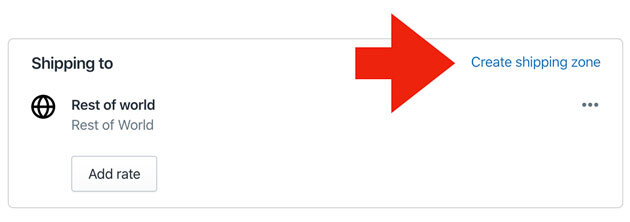
Locate the shipping zone for which you want to app to provide quotes. Click the Add rate button.
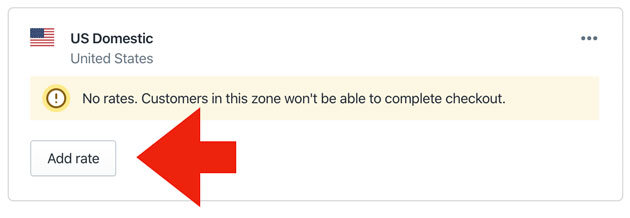
Select the option Use carrier or app to calculate rates.
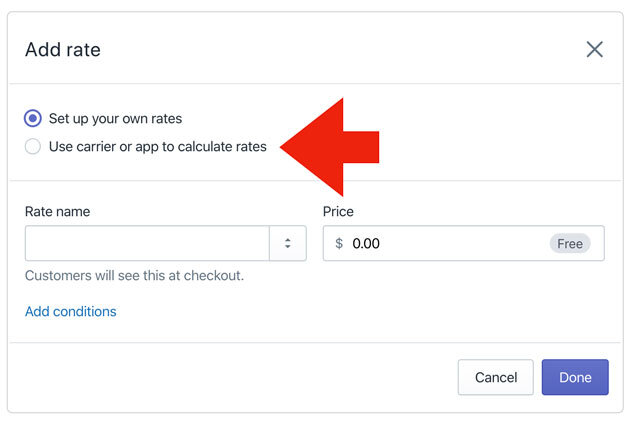
It may take a moment for Shopify to retrieve the list of apps capable of providing shipping quotes for your store. After it has, the appearance of the Add rate page will be similar to the image below. Perform the following actions:
- Select the app from the drop down list.
- Enable the Services are selected in the app preferences setting
- Click the Done button at the bottom of the page.
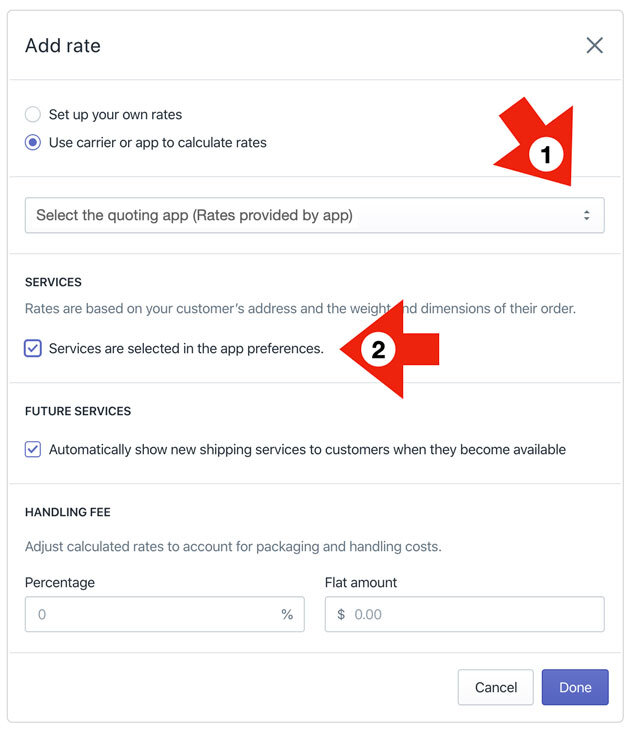
Repeat the steps above to enable the app for any other shipping zone. You should only enable the app in shipping zones that the app is capable of returning quotes for. Check the Features tab for origins and destinations that the app supports.
2. Choose the desired plan. |
Return to top. |
Begin by selecting Apps from the Shopify menu. Locate and click on the entry for the DIY Real Time Shipping Quotes app. You’ll initially see the Providers page, but start by using the app’s navigation menu to select Plans.
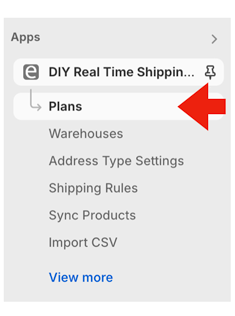
The active plan when the app is first installed will permit you to activate one shipping provider. If you want to activate more than one shipping provider, select one of the alternate plans.
3. Add Shipping Providers. |
Return to top. |
Click on the app’s name in its navigation menu.
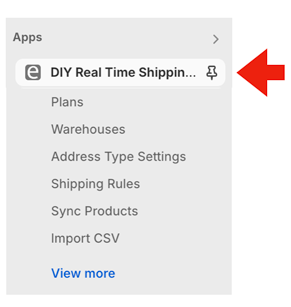
You’ll be delivered to the Providers page. Use this page to add the shipping providers that you want to enable in the app. You can activate as many shipping providers as allowed by the selected plan. Locate the shipping provider in the All Providers section of the page, and click on its Add account link.

Afterward, it will appear in the section with the heading, Installed Providers.

Repeat this step for each provider you want shipping quotes from.
4. Connect To The Provider’s API. |
Return to top. |
Now connect to the provider’s API (Application Programming Interface). Click on its Connection settings link.

Click on the link for the provider in the list below for provider-specific instructions. The instructions will load in a new tab in your browser. Repeat this step for each provider you want to activate. After successfully connecting to the provider(s), return to these instructions and continue to the next step.
List of supported providers
ABF Freight
A. DuiePYLE
Averitt Express
CDN Logistics
Central Transport
CH Robinson / FreightQuote by CH Robinson
Day & Ross
Daylight Transport
Echo Global Logistics
Estes Express
FedEx Freight
Gain Consulting
GlobalTranz
KDL Logistics
Kuehne+Nagel
Old Dominion Freight Lines (ODFL)
PITT OHIO
Polaris Transport
Priority 1
Quick Transfer
R+L Carriers
Redhawk Logistics
Roadrunner Freight
Saia
Southeastern Freight Lines
TForce
TQL (Total Quality Logistics)
Unishippers
Worldwide Express
XPO Logistics
5. Choose The Quote Settings. |
Return to top. |
A shipping provider’s quote settings determine the unique behavior of its integration. The Quote Settings for a given provider apply only to that provider although other providers can have similar settings. For example, all of the providers have a setting for Handling fee / markup. A handling fee entered for Provider A will have no effect on Provider B. To access the Quote Settings page, use the Shopify ADMIN navigation menu to navigate to Apps > DIY Real Time Shipping Quotes. On the Providers page, locate the shipping provider on the Installed Providers list and click on its Quote settings link.

Click on the link for the provider in the list below for provider-specific instructions. The instructions will load in a new tab in your browser. Repeat this step for each provider you want to activate. Afterward, return to these instructions and continue to the next step.
List of supported providers
ABF Freight
A. DuiePYLE
Averitt Express
CDN Logistics
Central Transport
CH Robinson / FreightQuote by CH Robinson
Day & Ross
Daylight Transport
Echo Global Logistics
Estes Express
FedEx Freight
Gain Consulting
GlobalTranz
KDL Logistics
Kuehne+Nagel
Old Dominion Freight Lines (ODFL)
PITT OHIO
Polaris Transport
Priority 1
Quick Transfer
R+L Carriers
Redhawk Logistics
Roadrunner Freight
Saia
Southeastern Freight Lines
TForce
TQL (Total Quality Logistics)
Unishippers
Worldwide Express
XPO Logistics
6. Identify Warehouse and Drop Ship Locations. |
Return to top. |
Select Warehouses from the app’s navigation menu.
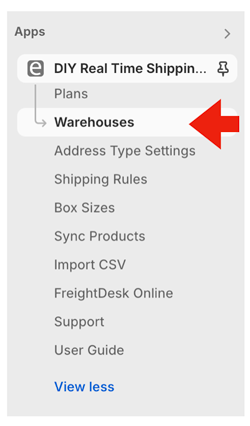
You can choose to use the app’s warehouse and drop ship functionality, or Shopify’s Locations feature to determine the shipment origins for orders placed on your store. Make your selection using the drop-down field labeled, How will your shipment origins be identified?
If you ship from only one location, it doesn’t matter which option you choose. However, your decision will matter if you ship from more than one location.
The app’s functionality assumes than an unlimited amount of inventory is available from each stocking location. The app has two types of stocking locations: warehouses and drop ship locations. If multiple warehouses exist, the one closest to the ship-to address is used as the ship-from location. This approach minimizes the estimated shipping costs and, if you have the setting enabled, presents your shopper with quicker estimated delivery dates. When an item is assigned to a drop ship location, it always ships from there.
Shopify Locations introduces the ability to do inventory tracking at multiple locations. Shopify Locations may be a good option if:
- You have visibility to the inventory levels at all your shipping locations.
- You will maintain accurate inventory counts in Shopify.
- You have items that can ship from more than one location, but not all locations.
Be aware that Shopify’s selection of the ship-from location isn’t influenced by its proximity to the ship-to address. Instead, you’ll list your locations in the order in which you want Shopify to look for available inventory. Once Shopify finds it, that location (or locations) becomes the ship-from address even if the next one on your list is across the street from the ship-to address and has enough inventory to fulfill the order. To get a better understanding of how Shopify Locations identifies the ship-from location, look over the example borrowed from Shopify’s Help Center.
If you choose to use Shopify Locations, you’ll lose visibility to how the app built the shipping quote when Shopify determines that more than one location is needed to fulfill the order. This occurs because Shopify makes individual shipping rate requests for each location and doesn’t provide enough information to relate each of them back to the same order. The section in this document titled, What you see, has examples of the information normally captured with an order. This information will be missing when Shopify Locations is used, and more than one location is used to fulfill the order.
Click the Add button in the appropriate sections to add warehouse and drop ship locations. Warehouses should have a complete inventory of all products not otherwise assigned to a drop ship location. If you have more than one warehouse defined, the warehouse closest to the shopper will be used to retrieve shipping rate estimates.
Drop ship locations usually represent vendors that supply items that you don’t inventory. These items are shipped directly to your customer on your behalf. An item can be assigned to only one drop ship location. Items not assigned to a drop ship location are assumed to ship from your warehouse(s).
When an order will ship from more than one stocking location (e.g. warehouse and drop ship locations or more than one drop ship location) a single figure will display for the shipping rate estimate labeled “Shipping”. The amount of the quote will be equal to the sum of the cheapest shipping option for each location.
A best practice is to define at least one warehouse, even if all your products are drop shipped. If all your products are drop shipped (you have no warehouses), make the highest volume drop ship location a warehouse. This ensures that shipping rate estimates will still be returned in the event a product was added to your catalog and its drop ship location wasn’t identified.
Warehouses vs. Drop Ship Locations
How the App Presents Quotes with Multiple Shipment Origins
| Nickname | Enter a nickname for the location. It will only be seen in the app settings. |
| Street Address | Enter the street address for the location. This is important for features in the app that need to know the distance between the location and the ship-to address. Examples are the In-store pick up and Local Delivery features. |
| ZIP | Enter the postal code for the location. Enter only the five digit ZIP Code for US addresses. |
| City | The plugin will attempt to prefill the City based on the postal code. Edit it if the prefilled value is incorrect. |
| State | The plugin will attempt to prefill the State based on the postal code. Edit it if the prefilled value is incorrect. |
| Country | The plugin will attempt to prefill the Country based on the postal code. Edit it if the prefilled value is incorrect. Use only the two character standardized country code. |
| Handling Fee / Markup | Increases the amount of the quote received for this location by a specified amount prior to displaying it/them in the shopping cart. The number entered will be interpreted as dollars and cents unless it is followed by a % sign. For example, entering 5.00 will cause $5.00 to be added to the quotes. Entering 5.00% will cause each quote to be multiplied by 1.05 (= 1 + 5%).
Note: The app has four different settings that can be used to mark up shipping quotes. They are applied to shipping quotes in the following order: 1) Product-specific Mark Up (Product settings); 2) Location-specific Handling Fee / Mark Up (Warehouse settings); 3) Service-specific Mark Up (Quote settings); and 4) General Handling Fee / Mark Up (Quote settings).
|
| Pickup Fees | Due to a gradual roll out of the pickup fee settings, they are not available for all shipping providers. The supported shipping providers are listed in the app above the settings. Refer to the list to confirm if the shipping providers you’ve enabled are supported. The list of supported shipping providers will continue to grow until they are available for all the shipping provider integrations.
Residential pickup required for LTL freight
Enable this setting if LTL freight carriers assess a residential pickup fee for this location. Liftgate pickup required for LTL freight
Enable this setting if LTL freight carriers assess a residential pickup fee for this location. |
The locations you identified in Shopify will be displayed on the page when you select Shopify Locations from the How will your shipment origins be identified? drop down. Any changes to your locations will need to be made in Shopify. Even if you choose to use Shopify Locations, you can still click the Edit link to enable and manage your in-store pickup and local delivery settings.
The Pitfalls of Shopify Shipping
6a. In-store pick up settings |
Return to top. |

| Enable in-store pick up | Check the box to enable the in-store pick up feature. |
| Offer if address is within (miles) | The distance in miles within which you’d like to offer in-store pick up. The distance is route miles (driving distance). Leave blank if you don’t want to use distance to determine if in-store pick up should be offered. If both distance and postal codes are used as evaluation criteria, in-store pick up will display if either condition is satisfied. |
| Offer if postal code matches | Enter the postal codes to which you’d like to offer in-store pick up. Enter only the five digit ZIP Code for US addresses. Separate postal codes with a comma. Leave blank if you don’t want to use postal codes to determine if in-store pick up should be offered. If both distance and postal codes are used as evaluation criteria, in-store pick up will display if either is satisfied. |
| Checkout description | Enter the description to use to identify the option in the checkout process. The most obvious candidate is In-store pick up, but you can make it anything you’d like. When the option for in-store pick up is displayed during checkout, it will be appended with the distance between the “ship-to” and “ship-from” addresses, and the address of the stocking location. |
6b. Local delivery settings |
Return to top. |
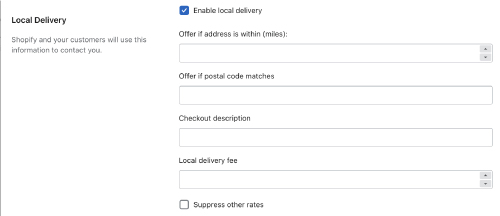
| Enable local delivery | Check the box to enable the local delivery feature. |
| Offer if address is within (miles) | The distance in miles within which you’d like to offer local delivery. The distance is route miles (driving distance). Leave blank if you don’t want to use distance to determine if local delivery should be offered. If both distance and postal codes are used as evaluation criteria, local delivery will display if either is satisfied. |
| Offer if postal code matches | The postal codes to which you’d like to offer local delivery. Enter only the five digit ZIP Code for US addresses. Separate postal codes with a comma. Leave blank if you don’t want to use postal codes to determine if local delivery should be offered. If both distance and postal codes are used as evaluation criteria, local delivery will display if either is satisfied. |
| Checkout description | The description to use to identify the option in the checkout process. The most obvious candidate is Local delivery, but you can make it anything you’d like. |
| Local delivery fee | Enter the amount to charge for local delivery. Leave blank to offer local delivery for free. |
| Suppress other rates | Check the box to show only the option for local delivery when the criteria for doing so (distance or postal code) is met. Only the rates from this app will be suppressed. If you have other shipping methods enabled for your store, they will be unaffected by this setting. Leave the box unchecked to have local delivery offered in addition to the shipping options normally displayed by the app. |
7. Address Type Settings. |
Return to top. |
Select Address Type Settings from the app’s navigation menu.
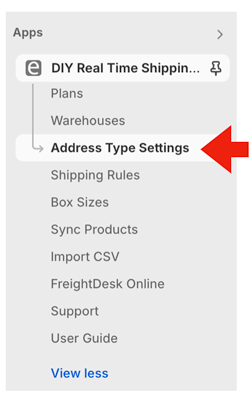
| Always quote residential delivery | When checked, quotes will always include the carrier’s residential delivery fee. |
| Do not return a rate if the shipping address appears to be a post office box | When checked, quotes will not be returned if the address as a post office box. |
| Automatically detect residential addresses | When enabled, the ship-to address is checked against a USPS database to determine if it is a residential address. If it is, the shipping quote will automatically include the carrier’s residential delivery fee. |
| Default unconfirmed address types to: | Displays only if the Automatically detect residential addresses setting is enabled. Select Residential or Commercial. In rare cases the app may be unable to confirm the address type. This occurs when a match for the address can’t be found in the USPS database. Invalid ship-to addresses are the most common reason for this. In extremely rare cases an address may be valid, but the match found in the USPS database has a low confidence metric. Choose how you want addresses treated in these cases. Choose what you want the address type to be in these cases. |
8. Shipping Rules |
Return to top. |
The Shipping Rules page gives you an opportunity to customize the behavior of the app. Select Shipping Rules from the app’s navigation menu.
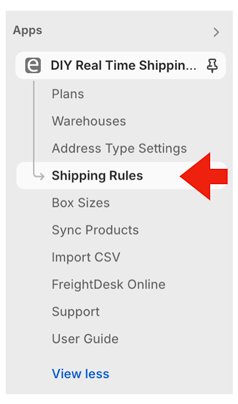
To introduce a rule, click the Add Rule button. Complete the form using the instructions below. Click the Save button afterward to implement the rule.
| Rule Name | Enter a name for the rule. The name is for your convenience. It will not be seen by your customers. |
| Type | Select the rule type. The following options are available:
Hide Methods
If the settings and the criteria of the filters are met, the shipping estimates normally provided as options by the app will be suppressed. Surcharge
If the criteria of the filters below are met, the shipping estimates provided by the app will be increased. Enter a dollar amount (e.g. 5.00) or a percentage (e.g. 5.0%). Discount
If the criteria of the filters below are met, the shipping estimates provided by the app will be decreased. Enter a dollar amount (e.g. 5.00) or a percentage (e.g. 5.0%). Override Rates
If the criteria of the filters below are met, the shipping estimates normally provided by the app will replaced according to the settings that follow. Show Cheapest Rates
Always applies to the entire Cart. When selected, the cheapest shipping rate from the enabled shipping methods will be presented during checkout. Free Shipping
If the criteria of the filters are met, the shipping rate estimates for the selected shipping provider and its selected services will be presented as free shipping. Items in the Cart that satisfy the enabled filters will not be included in the packaging solution generated by the Box Sizes or Pallets features. Large Cart Settings
This rule type is relevant only if you are using the Box Sizes feature. The Box Sizes feature uses an iterative algorithm to arrive at the optimal packaging solution. If you can have Carts that contain a large number of products (100+) it may take longer for the packaging algorithm to execute than Shopify allows. In this case, a “No shipping rates are available” message may display to the visitor. To avoid the message, use this rule to bypass the packaging algorithm. When bypassed, shipping rate estimates will be based only on shipment weight. |
| Apply to | Some rule types may not provide an option on how to apply the rule.
Cart
Choose this option if you want the shipping rule to apply to the entire Cart. Shipment
Choose this option if you want the shipping rule to apply only to individual shipments. For example, the app is capable of combining shipping quotes from multiple ship-from locations. If you want the rule to apply only to the shipments that meet the rule filter(s), then choose this option. If you want the rule to apply to all the shipments if any of the shipments satisfy the rule filter(s), then choose the option for Cart. |
| When the Type is “Hide Methods” | Shipping provider’s nickname Identify the providers whose rates are to be hidden if the settings and filters are met. If the rule settings and filters are met and it applies to the “Cart”, then the app will not present shipping quotes for that provider during checkout. If the rule filters are met and it applies to the “Shipment”, then the quotes for the shipment will not contribute to the sum of the shipping rates retrieved for the other ship-from locations. Provider services
Use the dropdown to select the services from the provider you wish to be hidden when the rule criteria are met. If you want all services from the provider hidden, don’t make any selections from this dropdown. |
| When the Type is “Discount” or “Surcharge” | Discount/Surcharge Amount Enter a dollar amount (e.g. 5.00) or a percentage (e.g. 5.0%). |
| When the Type is “Override Rates” | Display As Enter the text that should be used to identify the rate on the Shopify Shipping Methods page. Description
Enter the text you want to accompany the “Display As” text to describe it. Often this is used to convey the expected shipping interval (“Allow 5 to 7 days for delivery”) or something about the rate (“Promotional flat rate shipping”). Flat Rate
Enter the dollar amount of the rate that will be displayed when the rule filter(s) are met. Enter a zero (0) if you want to offer free shipping. Suppress other rates
Enable the checkbox if you want the override rate to replace the rates that the app would otherwise display on the Shopify Shipping Methods page. Leave it disabled if you want the override rate to be displayed in addition to the the real-time rates that the app will display on the Shopify Shipping Methods page. |
| When the Type is “Show Cheapest Rates” | Apply to:
LTL providers
The rule will apply only when multiple LTL providers are enabled to return shipping rate estimates. The cheapest option for each enabled service will be presented. For example, what is presented may include a rate for standard LTL service (no additional services) from one provider, and a rate for LTL service with liftgate delivery from another. Parcel providers
The rule will apply only when multiple parcel providers are enabled to return shipping rate estimates. If the rule applies, only the cheapest rate from among those returned will be offered. LTL and parcel providers
This rule will apply when both LTL and parcel providers are enabled and would return rate estimates. It combines the outcomes of the other settings. Presented to the visitor will be the cheapest parcel rate, and the cheapest LTL freight rate for each enabled service. (e.g. LTL freight, LTL freight with liftgate delivery, and any other enabled services.) Cheapest LTL or parcel
This rule will apply when both LTL and parcel providers are enabled and would return rate estimates. It will display the parcel or LTL outcomes, depending on which is cheapest. If the LTL shipping method has the cheapest rate, the visitor will be presented with options for each enabled service. (e.g. LTL freight, LTL freight with liftgate delivery, and any other enabled services.) |
| When the Type is “Free Shipping” | Shipping provider’s nickname Select the nickname of the shipping provider. If the shipping provider isn’t listed, then this rule is not yet available for it. Provider services
Select the services that you want to offer as free when the filter criteria is met. What is free?
This setting is not available to all the shipping providers with access to the Free Shipping rule. If you can access the setting, then you can specify which of the itemized charges for the selected service is free, and continue to have the others summed and used for the quoted shipping rate estimate. Leave this setting blank to have the service selected in the previous setting appear as a free option. Example – Offer Ground parcel service as a free option Example – Quote Ground parcel service but exclude the fuel surcharge
To continue to display a rate for Ground parcel service, but exclude fuel charge from the quoted rate, select “Ground” in the Provider services setting and “Fuel surcharge” in the What is free? dropdown. Label as
Enter the text you want to display to the visitor when free shipping is offered. The text will be used when the app will be presenting only one free shipping option. When the app returns more than one free shipping option, the carrier’s name for the shipping service will be used. |
| When the Type is “Large Cart Settings” | This rule is used to bypass the Box Sizes packaging algorithm. When bypassed, only weight is used to estimate shipping rates.
Max items
Enter the number of items in the Cart that will trigger the rule. Any number of items in the Cart in excess of the value entered will trigger the rule. Max weight per package
Enter a value for the maximum weight allowed per package in the event that the Large Cart Settings rule is triggered. |
| Filters | Below is a list of filters that can be used to target when a shipping rule is applied. Not every filter is available for each rule. The filters that are available for a shipping rule will appear on the settings page after the rule type is selected.
Filter by weight
Enable the checkbox if you want to use the weight of the cart as a criteria for the application of the rule. Enter the range for the weight in the From and To fields. The value entered in the From field will be included in the criteria. The value entered in the To field will be excluded from the criteria. If you enter “From 100” “To 150”, then a Cart with a total weight of 100 LBS will trigger the rule while a Cart with a total weight of 150 LBS will not. Consider the “To” field as the “Up to” value. Filter by price
Enable the checkbox if you want to use the price of the cart as a criteria for the application of the rule. Enter the range for the price in the From and To fields. The value entered in the From field will be included in the criteria. The value entered in the To field will be excluded from the criteria. If you enter “From 100” “To 150”, then a Cart with a total price of $100 will trigger the rule while a Cart with a total price of $150 will not. Consider the “To” field as the “Up to” value. Filter by quantity
Enable the checkbox if you want to use the quantity of items in the cart as a criteria for the application of the rule. Enter the range for the quantity in the From and To fields. The value entered in the From field will be included in the criteria. The value entered in the To field will be excluded from the criteria. If you enter “From 10” “To 20”, then a Cart containing 10 items will trigger the rule while a Cart with 20 items will not. Consider the “To” field as the “Up to” value. Filter by vendor
Enter the vendor name. The value entered must be an exact match for what you have entered on the Shopify Product Detail page in the Product Organization > Vendor field. Separate multiple entries with a comma. Filter by product tag
Enable the checkbox if you want to use the product tags of the items in the Cart as a criteria for the application of the rule. Enter the product tag. The value entered must be an exact match for what you have entered on the Shopify Product Detail page in the Product Organization > Tags field. Separate multiple entries with a comma. Filter by address type
Enable this checkbox if you want to use the address type (commercial or residential) of the ship-to address as a criteria for the application of the rule. You must have the feature to automatically detect residential addresses turned on (see Address Type Settings) for this filter to work. Filter by location
Enable the checkbox if you want to use the ship-to address as a criteria for the application of the rule. Select a country from the Countries dropdown field, and then the states or provinces from its dropdown field. You can add multiple countries, states or provinces to a rule. Apply rule…
Choose the radio button associated with the option on how you want the filters to apply to the rule. Available
Enable this checkbox if you want the rule to be applied. Disable it if you want to keep the rule settings for future use, but you don’t want to actively apply it. |
9. Box Sizes |
Return to top. |
The Box Sizes feature is optional and will allow you to retrieve hyper-accurate shipping rate estimates. With the Box Sizes feature enabled, you can identify:
- The sizes of the boxes you inventory.
- The rotational property of items that can be packed in a box with other items.
- Items that ship as their own package (Can’t be packed in a box with other items).
- Items pre-packaged to ship in more than one box.
When items in the cart can be packaged together, the app will identify the best box(es) to use for the order and send the packaging solution to the carrier when requesting rates. The packaging solution is saved as a step-by-step graphical illustration which you can access from the Order Details page. Use the step-by-step instructions to pack the order exactly as it was quoted.
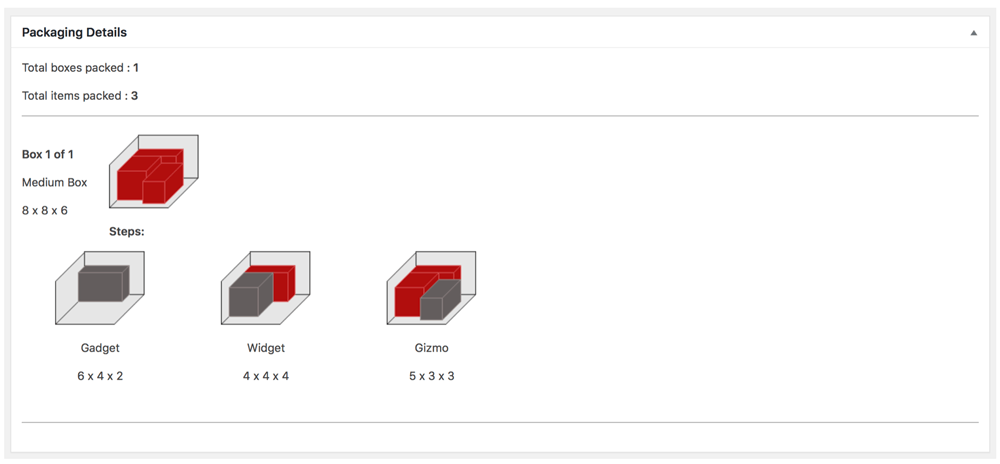
If you elect not to use the Box Sizes feature, only the weight of the Cart will be used for rating purposes which may result in shipping quotes that are less than what you will be billed.
Dimensional weight is an extremely important factor when calculating rates for parcel services. Have a clear understanding of the topic when deciding whether or not to use the Box Sizes feature. (Learn more about dimensional weight)
9a. Identify your standard box sizes |
Return to top. |
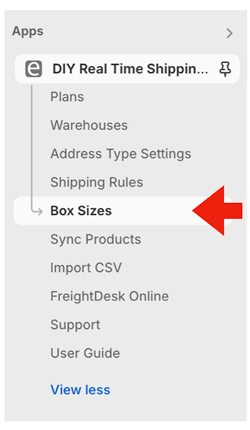
Follow the instructions below to enable the feature and add boxes.
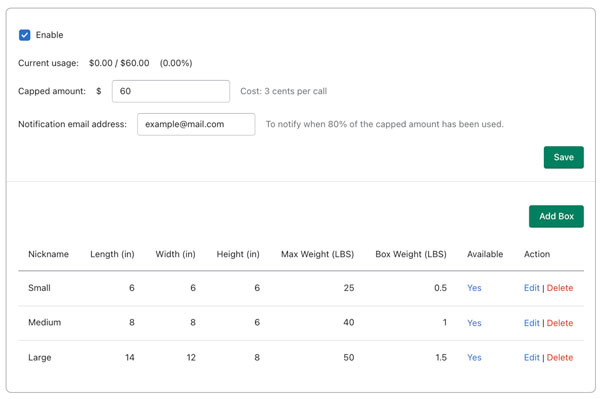
| Enable checkbox | Check this box to enable the standard box sizes feature. While enabled a charge of 3¢ for each calculated packaging solution will be incurred unless the capped amount for the billing cycle has been reached. If the capped amount has been reached you can re-enable the feature by increasing the capped amount. (Learn more about usage charges and capped amount in the Shopify Help Center.) |
| Current usage | Shows the usage of the feature at the time the page loads. |
| Capped amount | The amount entered into this field is the maximum you can be charged for the standard box size feature in a billing cycle. If this amount is reached the feature will stop working and the optimal packaging solution algorithm will be used instead. This may effect the accuracy of your shipping rates. You can increase the capped amount to re-enable the feature. |
| Notification email address | An email will be sent to the email address entered when the usage of the standard box sizes feature is 80% of the capped amount. Taking action to increase the capped amount immediately after receiving the email will mitigate the risk of the feature being disabled which can otherwise lead to less accurate shipping quotes. |
| Optimization mode | Maximize space utilization Choose this setting if you want the packaging algorithm to prioritize the amount of space used in each box. For example, two boxes may be selected for the packaging solution if they have a higher utilization percentage than using a single, larger box. Minimize the number of packages Recommended for most merchants.
Choose this setting if you want the packaging algorithm to prioritize the fewest number of boxes used for the packaging solution. |
| Packaging method when standard box sizes is disabled | Select the method you want the app to use to rate shipments if you choose not to enable the Standard Box Sizes feature.
Quote each item as shipping as its own package
Each item in the Cart will be quoted as shipping as its own package. Unless orders are shipped this way, the shipping rate estimates using this method will tend to be high. Quote shipping as all items are in one package
All the items in the Cart will be quoted as shipping in one box and the shipping rate estimates will be based on weight only. If the total weight of the Cart exceeds 150 pounds, the total weight will be divided in to multiple packages of equal weight. Shipping rate estimates using this method will tend to be low. Combine the weight of all items without dimensions and quote them as one package while quoting each item with dimensions as shipping as its own package
A hybrid of the other two options. Shipping rate estimates may be higher or lower than the actual shipping charges depending on the contents of the Cart. |
| Save button | Clicking the save button will save changes made to the fields located above the button provided the changes pass the field level validation. |
| Add Box button | Clicking this button will display a form for use to capture the box parameters. |
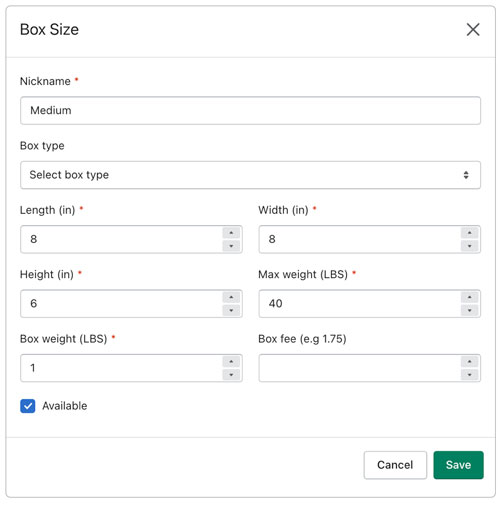
| Nickname | Enter a nickname for the box. This will be used to identify the box in the graphical representation of the packaging solution. |
| Box Availability | Available for all products Choose this option if the box will be available for consideration in all cases where a specific box is not required. Available only for specific products
Choose this option if the box will be used for specific products. You’ll assign the box to the product(s) in the product settings. |
| Box type | Select the box type. Special services like One Rate from FedEx and Flat Rate from the USPS require the use of their provided packaging. If you will be using one of these services, be sure to select the type of provider supplied box you will be using. |
| Length | Enter the length in inches. |
| Width | Enter the width in inches. |
| Height | Enter the height in inches |
| Max Weight | Enter the maximum weight, in pounds, that the box can weigh. This includes the weight of the box. |
| Box Weight | Enter the weight of the box in pounds. |
| Box fee | Enter an amount to charge a fee for the box. The fee will be added to the shipping quotes after the service level markup and the general markup/handling fee (found on the Quote Settings page) are applied. Leave the field blank if no fee is to be collected. |
| Available | Select this checkbox to make the box available to the algorithm that calculates the packaging solution. |
9b. Items that ship as multiple packages |
Return to top. |
When you enable the Box Sizes feature, a setting is available on the Product Shipping Parameters page to allow you to specify that the item ships as multiple packages. When you enable the setting, the item will appear on the Box Sizes page in the Items that ship as multiple packages section.
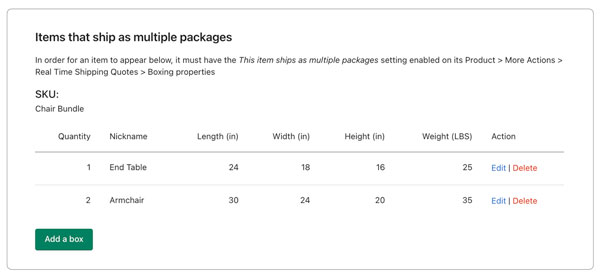
To add a box, click the Add Box button. A popup will display prompting you for the following information about the box:
| Quantity | Enter the number of boxes there are of this size and weight. |
| Nickname | Enter a nickname for the box. The nickname will be used to identify the box in the graphical illustration of the packaging solution. |
| Length | The length of the box in inches. |
| Width | The width of the box in inches. |
| Height | The height of the box in inches. |
| Weight | The weight of the box in pounds. |
| Box fee | Enter an amount to charge a fee for the box. The fee will be added to the shipping quotes after the service level markup and the general markup/handling fee (found on the Quote Settings page) are applied. Leave the field blank if no fee is to be collected. |
If you have an LTL freight provider enabled, it will use the Freight Class and Weight entered on the Product Shipping Parameters page when an LTL freight quote will be returned. However, if the Freight Class is set to Density Based (and the Item ships as multiple packages setting is enabled), then a freight class for the item will be calculated using the weight and dimensions of the boxes entered here.
10. Pallets |
Return to top. |
The Pallets feature is optional and will allow you identify the size of the pallets you keep in stock. It is a required feature if the pricing tariff with your LTL freight provider rates your freight dimensionally. With the Pallets feature enabled, you can identify:
- The sizes of the handling units (usually pallets) you inventory.
- The rotational property of items that can be placed on a handling unit with other items.
- Items that ship as their own handling unit (Won’t be put on a handling unit with other items).
When items in the cart can be placed on a handling unit together, the app will identify the handling unit(s) to use for the order and send the packaging solution to the carrier when requesting rates. The packaging solution is saved as a step-by-step graphical illustration which you can access from the Order Details page. Use the step-by-step instructions to pack the order exactly as it was quoted.

If you elect not to use the Pallets feature, the total weight associated with each freight class will be used for rating purposes.
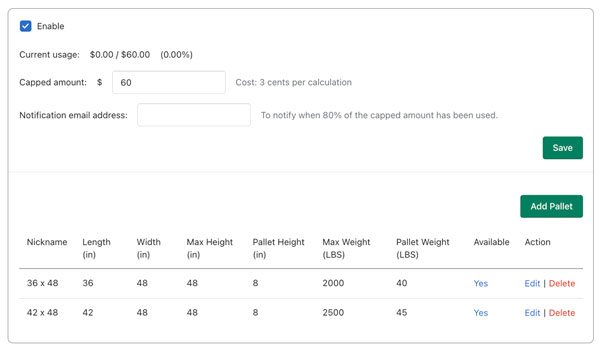
| Enable checkbox | Check this box to enable the pallet packing feature. While enabled a charge of 3 cents for each calculated packaging solution will be incurred unless the capped amount for the billing cycle has been reached. If the capped amount has been reached you can re-enable the feature by increasing the capped amount. (Learn more about usage charges and capped amount in the Shopify Help Center.) |
| Current usage | Shows the usage of the feature at the time the page loads. |
| Capped amount | The amount entered into this field is the maximum you can be charged for the Pallets feature in a billing cycle. If this amount is reached the feature will stop working. If your pricing tariff is dimensionally based, you will stop receiving LTL freight quotes. If your pricing tariff is based on the traditional NMFTA standard (weight and freight class) then you will still receive LTL freight quotes based solely on the total weight per freight class. You can increase the capped amount to re-enable the feature. |
| Notification email address | An email will be sent to the email address entered when the usage of the Pallets feature is 80% of the capped amount. Taking action to increase the capped amount immediately after receiving the email will mitigate the risk of the feature being disabled. |
| Save button | Clicking the save button will save changes made to the fields located above the button provided the changes pass the field level validation.. |
| Add Pallet button | Clicking this button will display a form for use to capture the pallet parameters. |

| Nickname | Enter a nickname for the handling unit. This will be used to identify the handling unit in the graphical representation of the packaging solution. |
| Length | Enter the length in inches. |
| Width | Enter the width in inches. |
| Pallet Height | Enter the height of the handling unit in inches. This is the height of the handling unit without anything on it. |
| Pallet Weight | Enter the weight of the handling unit in pounds. This is the weight of the handling unit without anything on it. |
| Max Height | Enter in inches, the maximum height that you’re willing to allow the handling unit to reach as items are placed on it. |
| Max Weight | Enter in pounds, the maximum weight that you’re willing to allow the handling unit to reach as items are placed on it. |
| Available | Select this checkbox to make the pallet available to the algorithm that calculates the packaging solution. |
Click the Save button to save the handling unit settings.
11. Sync product shipping parameters from another app from Eniture Technology. |
Return to top. |
The app detects that you have one or more other quoting apps from Eniture Technology. The convention used to name these apps usually begins with the shipping provider’s name followed by “Small Package Quotes” or “LTL Freight Quotes”. You can use this utility if you’d like to copy the product shipping parameters from the other apps.
Select Sync Products from the app’s navigation menu.
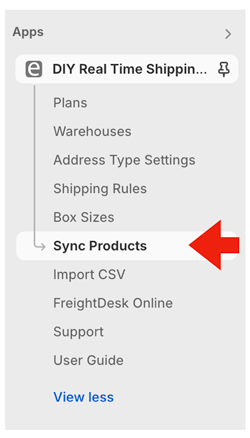
Enter your email address and then click the Sync products button.

You’ll receive an email notification when the syncing process is complete.
12. Product Shipping Parameters. |
Return to top. |
Now that the application settings have been established, it’s time to populate the product settings. You can do this through the app’s user interface, which is described in this step. Using the app’s user interface is convenient if you have a limited number of products to populate. If you have a lot of products to populate, you’ll find using the Import CSV Utility described later in the User’s Guide much more efficient.
Repeat these instructions for every product that you want the app to provide a quote for. Select Products from the Shopify menu. Locate the product on the list and choose it by clicking on it. You’ll be delivered to the product’s details page. Click the More actions button at the top of the page to reveal the installed apps and select the app from the list.

You’ll be delivered to a page on which you will enter the product’s freight class, weight, and dimensions. Enter the information prompted for, and then click the Save & Return button at the bottom of the page to return to the product’s Shopify product details page.
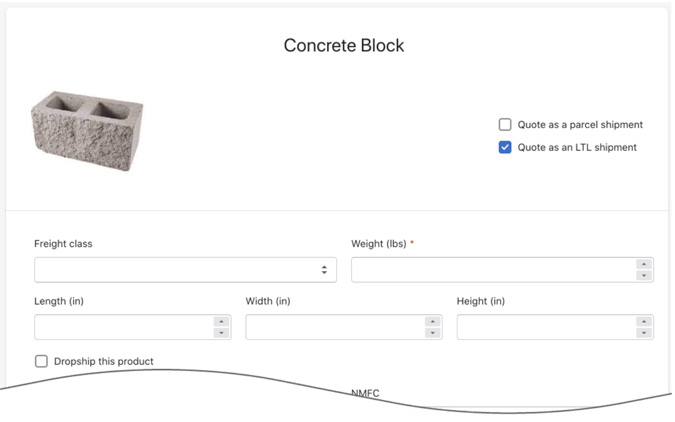
| Quote as… | Select the option that reflects the default shipping method for the product. If one unit of the product is the only thing in the cart and it would ship with a parcel carrier, choose Quote as a parcel shipment. If the product must ship with a LTL freight carrier, choose Quote as an LTL shipment. A set of rules govern what type of shipping rates (parcel or LTL freight, or parcel and LTL freight) are displayed during checkout. It’s possible for products that have the Quote as a parcel shipment setting enabled to be quoted as an LTL freight shipment. Learn more. |
| Weight | Required. Enter the weight of the product in pounds. You can enter weights out to three decimal places. Consider including the weight of any packaging materials that may be required to ship the product, such as cardboard, pallets and shrink wrap. |
| Freight Class | Required for LTL freight. Recommended for products with the Quote as a parcel shipment setting enabled if one of the LTL freight providers is also enabled in the app.
Select the product’s freight class from the drop down list. You may also select Density Based from the list, which will calculate a freight class on the fly using the product’s weight and dimensions. Although the density based calculation will return a freight class, selecting the actual freight class for the product is recommended since density is only one of four factors that the National Motor Freight Transportation Agency (NMFTA.org) evaluates when identifying a commodity’s freight class. You are solely responsible to identify the correct freight class of your product(s). If you need assistance, start by checking out this resource for some useful tips: Learn more about Freight Classes |
| NMFC | For LTL freight, commodities are more specifically identified by a combination of their “freight class” and “NMFC” number. In most cases, simply identifying the correct freight class is sufficient for quoting purposes. However, in rare cases an LTL carrier may require that the NMFC number be identified. If so, the requirement should be documented in your pricing agreement which is commonly referred to as the “account tariff”. If your LTL freight provider requires you to identify the NMFC number of your commodities as a prerequisite for obtaining a quote, enter it here. If not, leave this field empty. (Nearly all merchants will be able to leave this field empty.) |
| Length | Required for parcel quotes if the Standard Box Sizes feature is in use. Not required for LTL freight quotes.
Enter the length of the product in inches. It should include any incremental inches added by packaging materials that may be required to ship the product. |
| Width | Required for parcel quotes if the Standard Box Sizes feature is in use. Not required for LTL freight quotes.
Enter the width of the product in inches. It should include any incremental inches added by packaging materials that may be required to ship the product. |
| Height | Required for parcel quotes if the Standard Box Sizes feature is in use. Not required for LTL freight quotes.
Enter the height of the product in inches. It should include any incremental inches added by packaging materials that may be required to ship the product. |
| Boxing properties | These settings are active only when the Box Sizes feature is enabled for parcel shipping providers.
Box selection criteria
Use boxes available for all products
Default. Choose this option if the item can be packaged in any of the boxes defined in the Box Sizes settings. Use only specific boxes for this product
Choose this option if the product should only be packaged in specific boxes defined in the Box Sizes settings. When choosing this option, select the boxes from the associated drop down list. To make multiple selection, hold down the COMMAND button on a Mac, or the CTRL button on a PC. Allow item to be rotated vertically when placing it in a box
When enabled, the packaging algorithm will be allowed to rotate the item while optimizing the packaging solution. This item ships as its own package
Enable this setting if the item ships as its own package. The dimensions and weight entered for the item will be used for its shipping parameters. Usage charges are not incurred for items shipping as their own package. This item ships as its own package if it is the only item in the cart
Enable this setting if you want the product’s weight and dimensions used to obtain shipping rates when it is the only item in the Cart. The packaging algorithm will not run in this case, avoiding the usage charges incurred when determining the best available box for a shipment. This item ships as multiple packages (not compatible with the USPS integration)
Enable this setting if the item ships as multiple packages. The item will subsequently appear on the lower half of the Box Sizes page. Navigate to the Box Sizes page to identify the packages associated with the item. Usage charges are not incurred for items shipping as multiple packages. |
| Pallet properties | These settings are active only when the Pallets feature is enabled for LTL freight providers.
Allow item to be rotated vertically when placing it on a pallet.
When enabled, the packaging algorithm will be allowed to rotate the item while optimizing the packaging solution. This item ships as its own handling unit.
Enable this setting if the item ships as its own handling unit. The freight class, weight, and dimensions entered for the item will be used for its shipping parameters. Usage charges are not incurred for items shipping as their own package. |
| Markup | Enter a dollar amount (e.g. 5.00 for $5.00) or a percentage (e.g. 5.0% for five percent) to mark up the shipping charges when this item is in the cart. Leave this field blank if you don’t want the inclusion of this product in the cart to be the reason why the shipping quotes that are returned by the carrier are modified.
A dollar amount will be multiplied by the quantity of the item that is in the cart and the result added to the shipping quotes that are returned from the carrier before any markups on the Quote Settings page are applied. A percentage will be applied to the total value of the item in the cart (price x quantity x (1 + markup percentage)) and the result added to the shipping quotes that are returned from the carrier before any markups on the Quote Settings page are applied. |
| Fulfillment offset days | The setting is only relevant if you have the Display estimated delivery date setting enabled on the Quote Settings page.
When the app requests shipping quotes, it identifies a ship date. The estimated delivery date is dependent on the ship date. The Quote Settings page has three settings that are applied globally that will alter the ship date so that it aligns with your fulfillment operations. The product-level setting for Fulfillment offset days allows the offset to be different for individual products. The product-level setting for Fulfillment offset days takes precedent over its globally applied counterpart on the Quote Settings page. In cases where the Cart contains multiple products with different Fulfillment offset days, the largest number of offset days is used to adjust the ship date. Enter the number of days to offset the ship date for this product. |
| Drop ship this product | Check this box if this item is drop shipped from a location other than your warehouse. |
| Drop ship location | Select the drop ship location from the drop down. These locations are defined on the Warehouses page in the app settings that was described in step 4. |
| NMFC | On an account-by-account basis, some LTL freight providers will require that the commodity’s NMFC number be included in the rate request. If that is the case for your account with this LTL freight provider, enter the product’s NMFC number. |
| Hazardous material | Enable this setting if the product is subject to hazardous materials restrictions and fees. |
| Insurance | This setting will only display when a parcel carrier or one of the following LTL freight carriers is enabled: Worldwide Express Group (WWEX, Unishippers, GlobalTranz), SAIA, and Redhawk Logistics.
Enable this option to insure the shipment whenever this product is included in the cart. |
Logs |
Return to top. |
The Quote Settings page contains the Enable Logs setting. When enabled, the app’s navigation will include a tab to the Logs page. Up to 25 of the most recent transactions will appear on the Logs page. The Response column shows the outcome of each transaction. Click on a transaction’s response result to view its details.
When viewing the transaction details, click on the “+” symbols to expand the level of detail and “–” to collapse it. A basic understanding of Application Programming Interfaces (APIs) will be useful when viewing the logs.
What your customer sees. |
Return to top. |
Once you’ve completed the preceding steps, your Shopify store is ready to offer real time shipping quotes. The rates your visitors see will depend on the providers you’ve enabled and the settings you’ve chosen. Below is an example of the shipping methods page when an LTL freight provider is enabled, the cart is quoted as an LTL freight shipment, and the setting to offer lift gate delivery as an option is enabled.

What you see. |
Return to top. |
The app populates details related to the shipping quote in the Additional details widget on the Order Details page. The content of the widget falls into two categories: 1) Shipment Origin & Services; and 2) Shipment Content.
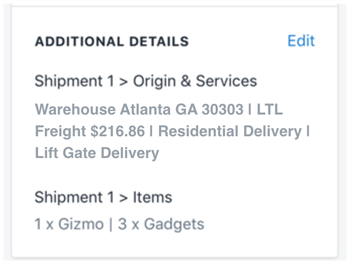
Shipment Origin & Services
This information block will identify the shipment origin, the selected carrier service and a list of any additional services (such as residential delivery) associated with the shipment. A separate Shipment Origin & Services information block will appear for each shipping location that will participate in fulfilling the order. This is particularly useful for stores with multiple warehouses and drop ship locations.
Shipment Content
A Shipment Content information block is presented beneath each Shipment Origin & Services information block. It identifies the products that were quoted as shipping from the location.
Note: The Quote Settings page allows you to choose to write the quote details to an alternate location that is accessible via the More actions link on the Order Details page. If you don’t see the quote details in the Additional Details widget, then one of the following is true:
- The shipping quote chosen during checkout was not one that was returned by the app.
- The quote details are being written to the alternate location per your settings.
- Another app overwrote the order details in which case you should change the setting in the app to have the quote settings written to the alternate location.
Updating products with the Import CSV Utility. |
Return to top. |
You can use the app’s Import CSV utility or Product API to enter or update the product shipping parameters. These method can be more time efficient than navigating in and out of the app’s user interface, particularly if you have lots of products. Which method to use will depend on the individual’s level of expertise. Instructions for both appear below.
You can’t use the Import CSV Utility or Product API to create products in Shopify. The products must exist in Shopify before using either method.
Using the Import CSV Utility |
Return to top. |
Click on Import CSV in the app’s navigation menu.
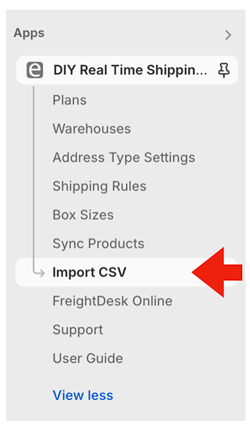
Use the link below to access instructions on how to…
- Download the CSV template.
- Use the filters to isolate the product/variant records you want to update.
- Populate the CSV file with your shipping parameters.
- Save the CSV file in the proper format.
- Import the CSV file to the app.
Using the Product API |
Return to top. |
Navigate to the Import CSV tab in the app preferences.

Scroll to the bottom of the page to the section titled, Update product shipping parameters via the API.

If an API token isn’t present, click the Create button. Copy the API token to your clipboard and follow the instructions in the Product API documentation which is linked below:
Shipping with FreightDesk Online |
Return to top. |
- How capture the cost of shipping on orders placed online.
- How to ship the order, including how to create the shipping label (or Bill Of Lading in the case of LTL freight), schedule the carrier to pick up the shipment, and update the customer with the tracking number.
Quoting apps, like this one, provide a solution for the first challenge. What are your options for the second challenge?
Option 1 – The carrier’s website: You can log into the carrier’s website and manually enter all of the relevant information. Carrier websites are free to use since the carrier makes money when you use them to deliver an order. However, if you have more than a handful of orders each day this approach is time consuming and ripe for data entry errors which can be costly to correct.
Option 2 – Shopify Shipping: Shopify Shipping offers pretty competitive rates for postal companies like the US postal service, and parcel companies like UPS, and DHL. But if you ship with another provider or have more than a low-to-moderate number of daily orders, you’ll find Shopify Shipping clunky and woefully inefficient.
Option 3 – Cloud-based Shipping Platforms: The next step up in capability are cloud-based shipping systems that will connect to your online store and retrieve the details of your orders, thereby eliminating the need for much of the manual data entry. Many of these shipping systems have arrangements with postal and parcel carriers that are on par if not better than the options available through Shopify Shipping. Where these systems excel is in the efficiency of the fulfillment process. That translates in to a much higher volume of shipments per unit of time. These systems are relatively inexpensive and the reduction in the amount of labor and time it takes to ship your orders will pay dividends.
Option 4 – FreightDesk Online: FreightDesk Online (freightdesk.online) is also a cloud-based shipping system. It enjoys all of the benefits of other cloud-based offerings but expands the solution in two ways:
- It makes use of the detailed information collected by Eniture Technology’s quoting apps (like this one) such as the packaging solution and the additional services included in the shipping option chosen when the order was placed.
- It provideds merchants access to more than two dozen LTL freight providers in addition to the typical postal and parcel integrations offered by other cloud-based solutions.
These expanded capabilities deliver you closer to true “click-and-ship” shipping than any other alternative, whether you’re shipping with a postal carrier, a parcel carrier, or an LTL freight provider.
How to connect your Shopify store to FreightDesk Online |
Return to top. |
First, if you don’t already have one, register for a FreightDesk Online account (https://freightdesk.online/register). You can connect multiple online stores to FreightDesk Online, so you don’t have to create separate accounts for each one.
The pricing for FreightDesk Online is á la carte. You’ll be able to pick a separate plan for parcel (and postal) shipments, and for LTL freight shipments based on the anticipated volume for each type of shipping. Your monthly subscription rate will be comprised of these two selections. You can begin a 30-day trial of both types of shipping by selecting Trial in the corresponding dropdown fields on the registration form.
After you complete the registration process, log into FreightDesk Online. Click on your avatar located in the top right-hand corner of the browser window. Copy your FreightDesk Online ID which will be located below your company name.
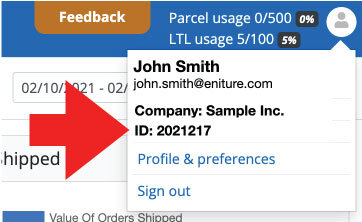
Return to the app settings and click on FreightDesk Online.

Enter your FreightDesk Online ID and click the Connect button.
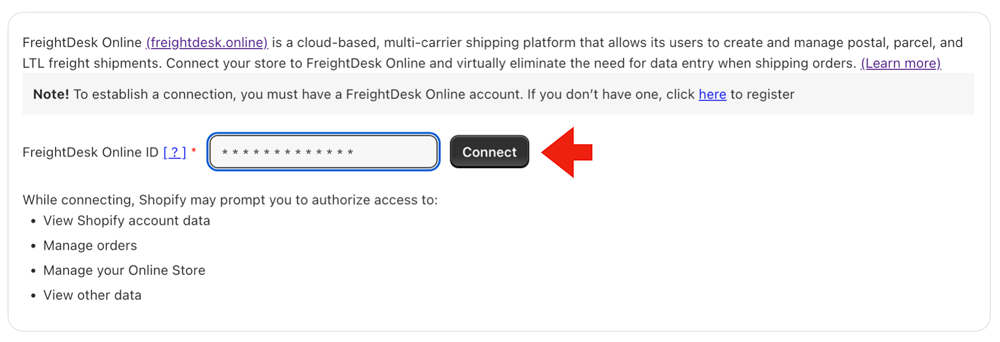
Complete the connection by granting the permissions that Shopify prompts you for.
Now that you’ve connected FreightDesk Online, unfulfilled orders will automatically appear in FreightDesk Online. To view them, log into FreightDesk Online and click on Orders in the navigation menu. You’ll need to connect your shipping providers before you can start shipping. You can find a quick start guide in FreightDesk Online by navigating to Help > Getting Started.
Using Validate Addresses |
Return to top. |

– Benjamin Franklin
Shipping to invalid addresses is expensive and avoidable. The cost of failed deliveries, returned shipments, and carrier fees can quickly change a profitable sale into a loss. Without interfering with the Shopify checkout process, Eniture Technology’s DIY Validate Addresses app immediately identifies orders that are safe to ship or notifies customers to confirm or correct the address. Customer updates are instantly reflected in Shopify so you know when it’s safe to ship the order.
The peace of mind knowing that you are shipping to a valid address can cost as little as 1¢ per order. The DIY Validate Addresses app is available in the Shopify App Store, and more detailed product information, including the User Guide, is available on eniture.com. The links below will take you to these resources:
DIY Validate Addresses Shopify App Store Listing
DIY Validate Addresses product information on eniture.com

